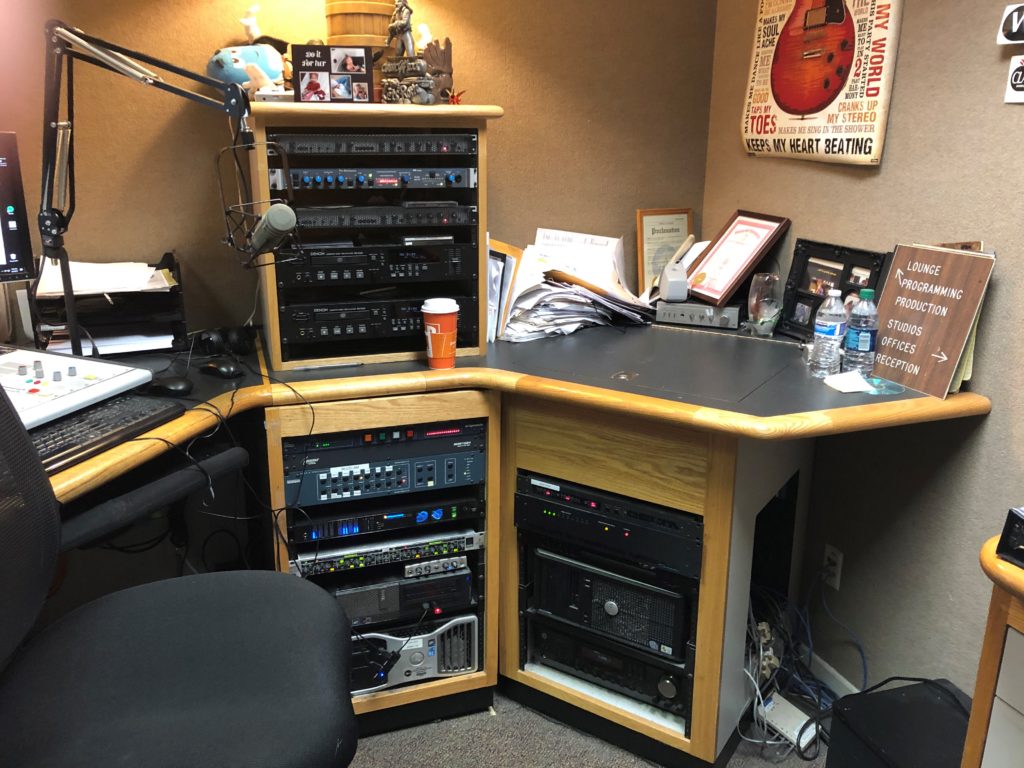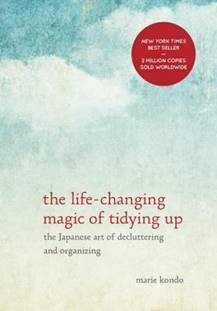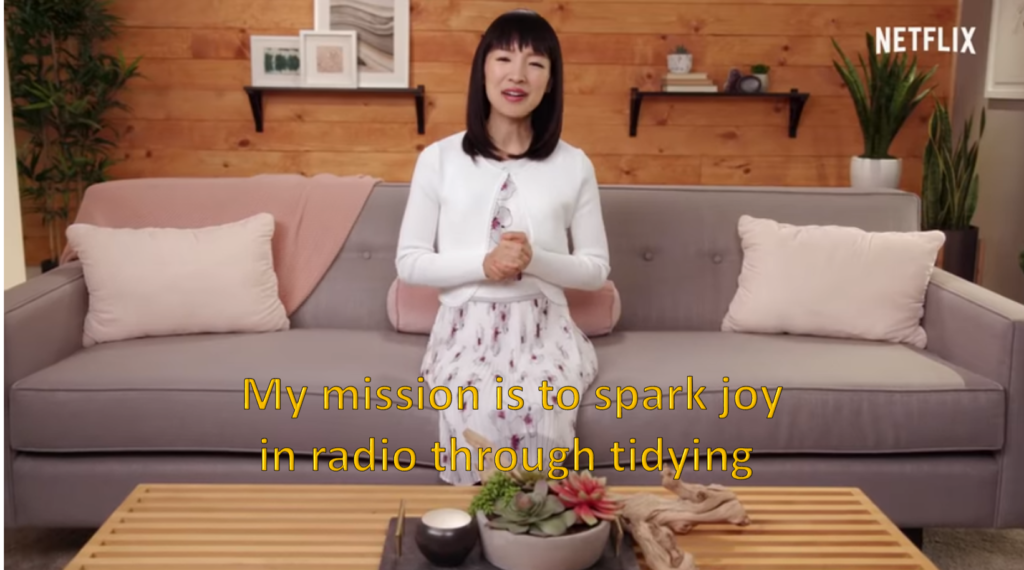
Back to 2019 and a still-timely blog post while some of those New Years resolutions are still valid. This one’s about “cleaning out our closets” to paraphrase the renowned Detroit philosopher, Marshall Mathers, once wrote.
We all have clutter in our lives – and radio stations are no exception. Sure, there’s the air studio – like the one above – that just seems to collect “stuff” over the years. That’s not surprising for rooms occupied for long periods of time by diverse groups of creative people trying to make themselves feel comfortable.

Then there’s the clutter that’s actually on the air – the excesses and other baggage stations collect over time, adding to the commercials and other barriers to an enjoyable listening experience. Sometimes, it reaches the point where it’s time to clean things up.
Veteran radio programming exec, Buzz Knight, calls it “mowing the lawn.” That translates to cleaning up your radio station, especially after longish periods without a whole lot of organizing. Oftentimes, station get in a groove where they do the same things in the same way for years – without honestly evaluating the value of their programming, promotion, marketing, and positioning.
Now this process has become validated by a best-selling book and wildly popular Netflix TV series aimed at consumers literally cleaning up their respective acts…and lives.
In today’s post, Jacobs consultant, Mike Stern – along with his wife, Jules – demonstrate the emerging art of “tidying up,” and specifically how it applies to your radio station or your office (that’s the part I’m thinking about).
No one ever said Mike and Jules don’t just talk the talk. They walk the walk. And they tidy up pretty well. – FJ
February 2019
Author Marie Kondo’s book “The Life-Changing Magic of Tidying Up: The Japanese Art of Decluttering and Organizing” has been all the rage for quite a while. And now it has new life through a Netflix series where the author (and her translator) teach the system to people with too much stuff. Beyond “Bird Box” and the Fyre Festival documentary, Kondo has generated some serious buzz on Netflix – and now others are getting the message.
How hot is this trend? “Kondo-ing” has become a verb – now synonymous with the act of decluttering your life. (Kondo even offers advice about how to tidy up your Twitter feed.) While I haven’t read the book myself, my wife (and co-author of this post) Jules certainly has – and she’s taking action.
So far, she hasn’t applied  Kondo’s method to everything we own, but she did use it to sort through her closet. Her before-during-after photos are posted below.
Kondo’s method to everything we own, but she did use it to sort through her closet. Her before-during-after photos are posted below.
The buzz about the book and the TV show, along with seeing how it radically improved Jules’ closet, led me to wonder if Kondo’s system could be adapted to radio station programming.
The book’s main principle is that if a possession doesn’t spark joy, you should let it go. To determine what stays, you are instructed to pile every item of a certain type – like clothes, books or papers – in one spot. Then hold each individual piece and decide if it, in fact, sparks joy.
If it does, it stays. If not, it has to go. There is no middle ground. But that isn’t all there is to “tidying up.” Here are a few other key principles Jules picked out that relate to radio programming:
Make “tidying up” a special event not a daily or regular chore.
If you try to tidy a little a day you’ll be tidying forever. Instead, treat this like a special project where you set aside time on your calendar. Kondo says if you do it all at one time you will see the results and dramatically change your mindset. Tidy a little at a time and the results aren’t visible.
This is certainly relevant to radio stations where everyone is always busy. Try to tidy your station a little at a time and it will be too easy to put it off for more immediate issues. It’s better to set aside some time – like maybe when your consultant comes to town – and get it done.
Here are 5 tips about how to get started:
1. Sort by category, not location.

Sorting your personal book collection requires every book in your house in the pile. Not just the books taking up space above your headboard, the ones in your home office, or the books in your spare room. Similarly, many radio stations have things in multiple places, like production, which can be in the automation system, the production director’s computer, the Vox Pro, the instant replay, various computers, and probably other places I’m probably not thinking of. Sort it all at one time.
2. Does it spark joy… for the listener?
The idea for your home is to hold every item in your hand and decide “does it spark joy?” This is where things are different for a radio station. Instead of asking if it sparks joy for you, the question is, does it spark joy for the listener? This is where research, listener groups and industry information like ratings, M Scores and even charts can help you make decisions.
3. Focus on the “good stuff”
Kondo stresses the importance of focusing on what to keep, not what to throw away. It’s not just about getting rid of things. It’s more about finding and keeping what sparks joy. Ask, what is great about your station? Then keep things that enhance the brand and truly add to your station’s sound.
4. When you come across something that’s hard to discard consider carefully why you have that specific item in the first place.
Consider when it became part of your station and the meaning it had for your brand then. Reassess the role it plays now and you’ll be surprised how many things have already played their role and can be let go.
5. Don’t hide those guilty pleasures
If something sparks joy for your audience, don’t hide it away. Even things that aren’t core to your station mission might still have a place because they meet the main criterion of sparking joy for listeners.
Kondo suggests taking the things you like but don’t want others to see, or in the case of radio programming, things that aren’t quite on-brand, and find a way to display them less publicly. Like using podcasts, videos and other social platforms for content that is appropriate for a smaller, more focused part of your audience.

So, with all this in mind, here are some areas of your station that might warrant Kondo-izing – whether you work for a public, commercial or Christian station:
Songs: This is the obvious one. Do all the titles in your library spark joy for your listeners? Are some mere “place-holders” – taking up space but doing little to spur happiness, memories, discovery?
Talk topics: Are your hosts defaulting to many of the same, repetitive topics or familiar guests? Digging deeper to stimulate conversations and spark some joy (or some controversy) is the goal. It means looking for new topics, different guests, and novel treatment on talk shows?
Rotations: Are you holding on to category counts and rotation lengths because that’s what you’ve always done? Do you have too many powers when the music isn’t strong enough to support them? Could your gold categories rotate faster so the songs that spark the most joy for your audience play more often? How can you make the really good stuff more prominent on your music station?
Imaging: Does every piece of imaging on the station spark joy for your listeners? Are some worn out and in need of replacing?
Features/programs: Have your special/weekend shows and features been in the “programming closet” for too long? Do they spark joy or are they place-holders? What about syndicated or specialty shows? Are you running programming that is no longer as relevant as it once was?
Benchmarks: Oftentimes recurring bits are developed to capitalize on a moment or an idea and wind up outliving their usefulness. Do your benchmark features resonate and give you audience something to look forward to?
Digital elements: Are the station’s social posts, tweets, podcasts, videos and other elements likely to spark joy with your audience? Or are you simply self-promoting your features, contests, and benchmarks? Oftentimes, the station website is the least likely content hub to be updated, especially talent profiles.
Talk: Since the dawn of the PPM era, talk has become synonymous with bad ratings. But that’s a gross oversimplification. Useless talk – banter and segments that go nowhere, are unprepared, and waste the listener’s time – is the culprit. And part of the process of decluttering is to focus on what your talent says and how they say it. Crutches seep into presentations among personalities in music, talk, and even podcasts. Kondo-izing your talents’ talk segments can go a long way toward sparking audience joy.
Excess Patrol: That’s what Fred calls it. Looking at your entire on-air (and online) product, and questioning content, features, talk, commercials, promos and everything else that contributes to a less-than-tidy environment. What’s on the air that has lost its purpose? What would a consultant hear the first time she monitored your station? 🙂

If you buy into Marie Kondo’s program here is a final piece of advice. She writes, “Despite the drastic reduction in their belongings, no one has ever claimed to have a problem later because I told them to get rid of something. The reason is very clear: discarding those things that don’t spark joy has no adverse effects whatsoever. It’s a strong reminder that they have been living all this time surrounded by things they don’t need.”
While it might be a frightening concept, tidying your station could help you spark even more joy with your listeners, and who knows, maybe with Nielsen, Eastlan, and Numeris, too.
Tidy away.
Marie Kondo has recently made the talk show circuit. A couple nights back, she helped Stephen Colbert tidy up his anchor desk. And last week, Jimmy Kimmel took us into his office for some serious Kondo-izing. You can watch the Kondo-ing process below:
- Does Your Radio Station Need A Princess? - December 17, 2024
- With A Name Like Smucker’s… - December 10, 2024
- Kondo And Romo:The Pros And Cons Of Regression - February 10, 2023





Leave a Reply